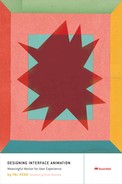0%
29Chapters
0-1Hours read
0kTotal Words
Book Description
Effective interface animation deftly combines form and function to improve feedback, aid in orientation, direct attention, show causality, and express your brand’s personality. Designing Interface Animation shows you how to create web animation that balances purpose and style while blending seamlessly into the user’s experience. This book is a crash course in motion design theory and practice for web designers, UX professionals, and front-end developers alike.
Table of Contents
- Cover Page
- Title Page
- Copyright Page
- Contents
- How to Use This Book
- Frequently Asked Questions
- Foreword
- Introduction
- Part I: The Case for Animation
- Chapter 1: Why You Can’t Ignore Animation
- Chapter 2: You Already Know More About Animation Than You Think
- Not Just for Cartoons
- Timing (and Spacing) Really Are Everything
- Follow-Through and Overlapping Action
- Anticipation
- Secondary Action
- Arcs
- Squash and Stretch
- Slow In and Slow Out
- Exaggeration
- Solid Drawing
- Straight Ahead and Pose to Pose
- Appeal
- Staging
- Developing an Eye for Animation
- Staying on Point
- Chapter 3: Modern Principles of Interactive Animation
- Part II: Using Animation to Solve Design Problems
- Chapter 4: Using Animation to Orient and Give Context
- Chapter 5: Using Animation to Direct Focus and Attention
- Chapter 6: Using Animation to Show Cause and Effect
- Chapter 7: Using Animation for Feedback
- Chapter 8: Using Animation to Demonstrate
- Chapter 9: Using Animation to Express Your Brand
- How Your Brand Moves Tells Its Story
- Defining Your Brand in Motion from the Bottom Up
- The Motion Audit
- Evaluate Your Existing Animation’s Design
- Evaluate Your Existing Animation’s Purpose
- Define Your Brand in Motion from the Top Down
- The Words You Use to Describe Your Brand
- Referencing Motion from Real Life
- Staying on Point
- Part III: ANIMATION IN YOUR WORK AND PROCESS
- Chapter 10: Where Animation Fits in Your Design Process
- Starting the Animation Discussion Early in Your Process
- Identifying Where Animation Could Be Most Helpful
- Sketching and Storyboarding Animation Ideas
- The Purpose of Storyboards
- When to Use Storyboards
- Do You Have to Use Storyboards for Interface Animation?
- Create Animation Prototypes
- When to Use Animation Prototypes
- Animation in Your Style Guide
- Why Document Animation?
- Always Communicate
- Staying on Point
- Chapter 11: Prototyping Your Animation Ideas
- Chapter 12: Animating Responsibly
- Conclusion
- Index
- Acknowledgments
- About the Author
- Footnote
- Chapter 10: Where Animation Fits in Your Design Process
